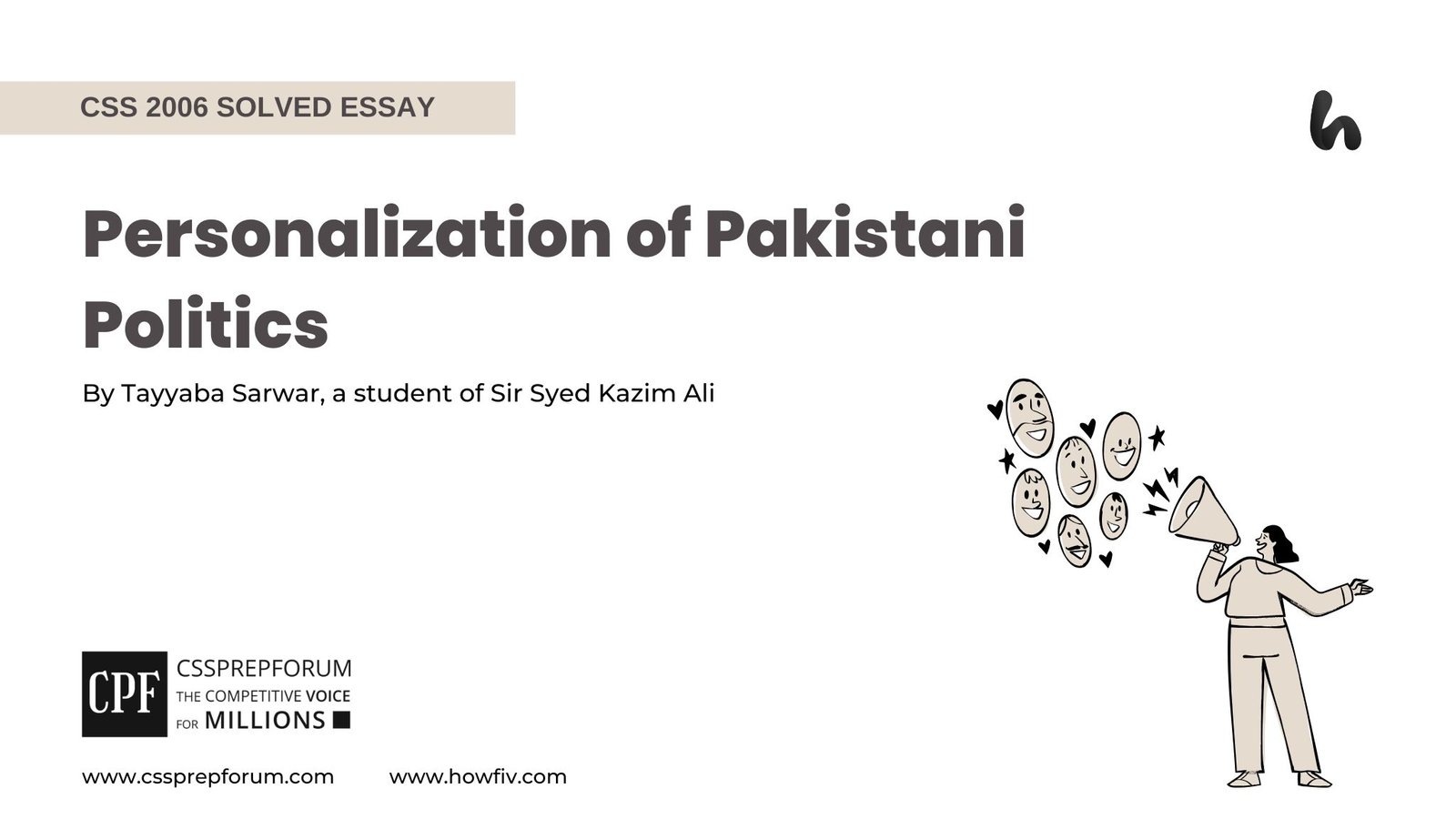CSS 2016 Solved Current Affairs Past Papers | Strategic Competition between China and the US
The following question of CSS Current Affairs 2016 is solved by Sir Ammar Hashmi, the best Current Affairs Coach, on the guided pattern of Sir Syed Kazim Ali, which he taught to his students, scoring the highest marks in compulsory subjects for years. This solved past paper question is uploaded to help aspirants understand how to crack a topic or question, write relevantly, what coherence is, and how to include and connect ideas, opinions, and suggestions to score the maximum.

Question breakdown
This question has two main parts: The first requires an overview of the emerging strategic competition between China and the US, and the second requires its impact on the global order.
Outline
1-Introduction
2-Understanding the term “strategic competition”
3-Exploring the emerging strategic competition: from post-Cold War till today
4-Analysing the impacts of rising strategic competition between China and the USA on the global order
- ✓The rise of trade war
Evidence: The Peterson Institute for International Economics (PIE) states that the ongoing trade war between the USA and China has reduced global GDP growth by approximately 0.5%.
- ✓The fight over technological supremacy
Evidence: the US restrictions on China’s Huawei over security issues. In the same way, China is trying to take the front seat in the expansion of the semiconductor industry.
- ✓The ideological warfare
Evidence: US-led capitalism vs Chinese authoritarian governance models
- ✓The status competitiveness
Evidence: the exchange of harsh state behaviours between the two gigantic powers has been growing at economic, political, ideological, and strategic levels, further strengthening through the ongoing clashes in different regions
- ✓The dead-end South China Sea(SCS) conflicts
Evidence: strong militarization by the USA and China in the South China Sea
5-Critical Analysis
6-Conclusion

Introduction
The rise of the twenty-first century has constantly been under the changing dynamics of power rivalry and strategic competition, impacting the global world order. Expanding the point, it is the old ritual of balancing hegemony in the international system by switching between the unipolar, bipolar, or multipolar world order. The USA and China, the two power giants, are fighting hard to gain global supremacy by taking different steps and supporting their regional allies, ultimately tilting towards the multipolar world order. As an illustration, the USA started a trade war in 2018 against China, which has growing economic potential. Likewise, China has strengthened itself in the semiconductor industry to resist American global hegemony. Also, the competitiveness between the powers and the strong militarization by the USA and China in the South China Sea, along with their regional allies, marked the shift of the global order towards multipolarity. Thus, the arguments mentioned above prove the shift of the world order from unipolar to multipolar. This question addresses the emerging strategic competition between China and the USA and its impacts on the global order.
Understanding the term “strategic competition”
Before diving into further details, it is important to understand the key term “strategic competition”. In simple words, it is a kind of rivalry among the states to achieve the key interests of one country under the pressure of other states. According to the Journal of Indo-Pacific Affairs, “strategic competition is an active rivalry between the states that perceive their fundamental interests under threat by the opposite party.” Likewise, the SAIS Review of International Affairs marks the understanding of strategic competition as competitive state vs state activity, lying in between cooperation and total war but a little less than armed conflict and violence. The main reason behind it is that it involves economic and cyber warfare, military threats, alliance-making, information competition, espionage, and intellectual property theft. To illustrate, the ongoing rivalry between the USA and China revolves not only around the technological sector but also the economic line, which is an apt portrayal of strategic competition. Similarly, the American think tank RAND Corporation analyzes “both the USA and China is leading to the deployment of 5G networks that are crucial for their economic growth and national security, marking the U.S to restrict Chinese technological companies like Huawei and helping China to accelerate its semiconductor industry, ultimately increasing trade competition and institutionalizing international organizations expanding beyond technological advancement.
Exploring the emerging strategic competition: Changing the trends of world order from post-Cold War to today.
Digging deep into the main arguments without exploring the changing trends of world order is useless; that’s why examining the changing trends of strategic competition and the changing world order since history is important. After the Cold War, the global world headed towards unipolarity, with the US being the sole hegemon, especially after the incident of the Berlin Wall in 1991. Stepping forward, the rise of the 21st century witnessed the dawn of the global south with some major shifts in falling economic trends of the Western bloc -Europe and the USA and the rising Chinese economy. However, this particular variation in geostrategic trends could not be named as bipolar but multipolar owing to the dominance of other regional players, like the prominence of Russia, India, Japan, South African nations, and European countries with the persistence of regional happenings, like Ukraine-Russia war, Brexit, the Arab Spring, Israel-Palestine conflict, CPEC, OBOR, QUAD, and AUKUS. In conclusion, the constantly growing global and regional developments, amalgamated with hard and soft powers, facilitate the multipolar world order.
Analysing the impacts of rising strategic competition between China and the USA on the global order
- ✓The rise of trade war
To begin with, the rise of the trade war is one of the major impacts of the emerging strategic competition between China and the USA, casting far-reaching implications on global trade and the economy. Exploring more details, the origin of the trade war between the two power giants during the Trump Era has introduced the concept of trade barriers and tariffs that have increased prices for consumers and business owners worldwide, ultimately strengthening geoeconomic and geopolitical tensions. As an illustration, the Peterson Institute for International Economics (PIE) states that the ongoing trade war between the USA and China has reduced global GDP growth by approximately 0.5%. Moreover, the imposition of trade tariffs has severely disrupted global supply chains by affecting major sectors like agriculture and electronics, forcing large companies to reevaluate their supply chain strategies. To conclude, the trade war has worsened economic growth globally, changing world order dynamics by putting the United States economic status at risk.
- ✓The fight over technological supremacy
Next, another rising impact of the emerging strategic competition on the global world order is the race to gain technological supremacy over each other. Advancing further, this race has not only strengthened the US-China contentions but has also severely crushed each other’s innovative technologies. It is evident from the US restrictions on China’s Huawei over security issues. In the same way, China is trying to take the front seat in expanding the semiconductor industry. This shows that the rising strategic competition between the two gigantic powers is putting the existing world order in question, giving birth to the rise of various key players.
- ✓The ideological warfare
The ideological warfare is the next significant impact of the emerging strategic competition between China and the USA. To expand the argument, the conflicts between the two big powers also revolve around US-led capitalism and China’s nationalist view, making it impossible for the world to head towards peaceful coexistence. Many geo-strategy study experts believe that the US’s dominant position in the world order would seem less hostile if it also held a democratic structure; in contrast, China follows state-led, authoritarian governance models under the Chinese Communist Party (CCP), leading towards the birth of a multipolar world order. This indicates that the existing war of ideological framework is rearranging the global structure by creating more and more options for other nations, as China does not only see herself as the ideological competitor of the USA but also as the economic and strategic rival.
- ✓The status competitiveness
Furthermore, the emerging strategic competition between the USA and China has strengthened the competitiveness of status between the two rivals. Moving ahead, the Sino-U.S. clash is not only creating the space of global status competition for the main actors but also helping regional powers- the allies of the USA and China- to raise their heads in this power game, impacting the existing world order. It is quite evident from the exchange of harsh state behaviours between the two gigantic powers that have been growing at economic, political, ideological, and strategic levels, further strengthening through the ongoing clashes in the Middle East, the sea conflicts in the South China Sea, the changing policies of India, and the strong technological build-up of Russia and Korea. Thus, it clearly shows that the persisting competitiveness of hegemony has tilted the existing world order towards multipolarity.
- ✓The dead-end South China Sea(SCS) conflicts
Last but not least, the emerging strategic competition between China and the USA has a military impact on the region of South Asia. This is evident from the never-ending disputes in the South China Sea between the USA and China, which display strong military influence. Both of the powers have created a war-like situation in the sea by engaging their allies as the SCS-bordered countries like China, Malaysia, Brunei, and Taiwan have made territorial claims. In contrast, the military occupation in the Southeast Asian region by various international actors like the USA, Japan, and India for securing free navigation rights has disputing elements in the South China Sea area. However, the unavoidable war-prone factors have ultimately given space to many rising regional powers to gain a presence in the strategic competition, eventually shifting towards the multipolar world order.
Critical Analysis
To investigate critically, the rise of the twenty-first century is marked by the geo-strategic competition with China, growing economic potential, challenging the U.S. sole hegemony. More specifically, China dominates the emerging world order through economic investments in trade and exports, artificial intelligence, 5G technology, and renewable energy projects, strengthening its hegemony in the third world. On the other hand, the USA has taken many anti-China measures to curtail its rise in the international system by launching a trade war, initiating the dialogue in the U.S bloc through the AUKUS and QUAD, supporting the Taiwan issue, and enhancing militarization in the South China Sea. However, the ongoing rivalry between the two states marks that they are constantly striving to gain global supremacy, which has given strength to many other regional powers, ultimately heading towards the making of a multipolar world order.
Conclusion
To conclude, strategic competition revolves around the rift between the two states that feel threatened by each other regarding their major national interests. The emerging strategic competition between the USA and China has strongly impacted the global order due to the rise of trade wars, status competition, and growing regional conflicts. Moreover, this strategic rivalry has surrounded the two power giants and taken other regional powers like Russia, India, SCS-bordered countries, and European nations. As a result, this competition between the two big powers is casting dire impacts on the global order by giving rise to a multipolar world order.

CSS Solved Past Papers’ Essays
Looking for the last ten years of CSS and PMS Solved Essays and want to know how Sir Kazim’s students write and score the highest marks in the essays’ papers? Then, click on the CSS Solved Essays to start reading them.
CSS Solved Essays
CSS Solved General Science & Ability Past Papers
Want to read the last ten years’ General Science & Ability Solved Past Papers to learn how to attempt them and to score high? Let’s click on the link below to read them all freely. All past papers have been solved by Pakistan’s top CSS GSA coach having the highest score of their students.
General Science & Ability Solved Past Papers












